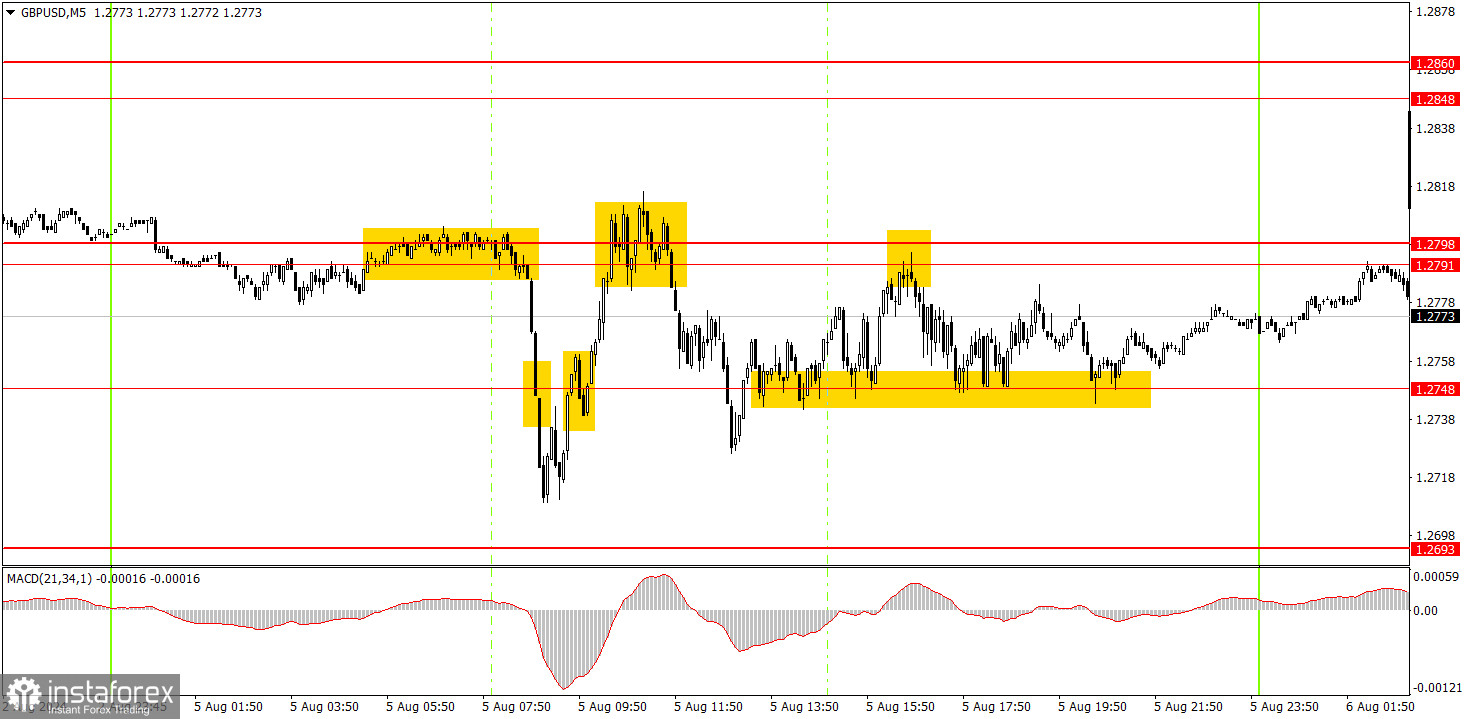Analyzing Monday's trades:
GBP/USD on 1H chart

On Monday, the GBP/USD pair tried to sustain its decline, which is evident. Over the past seven months, the British pound has consistently leaned towards growth. It managed to trade higher even when there was no reason or basis. However, yesterday, when, for example, the euro continued to rise, the British pound remained within the descending channel. If the reason for the new wave of selling the U.S. dollar was the threat of a recession in America and the possible emergency rate cuts by the Federal Reserve, then why didn't the British pound rise?
Again, we return to the logic and pattern of current movements. As we can see, there are none. Technically, the downward trend persists, suggesting further declines. The pound may have exhausted all of its bullish factors, so even a potential, unplanned rate cut by the Fed may not provide it with the support it needs. In any case, buying the pair before the price consolidates above the descending channel is not advisable.
GBP/USD on 5M chart

Numerous signals were formed in the 5-minute time frame on Monday. Not all were perfect, but the pair showed good volatility for the third consecutive day, so market participants could trade the pair rather than observe it. Newcomers could earn from the first sell signal near 1.2791-1.2798. Traders could also profit from the third buy signal—the target was reached. Subsequently, the sell signal near the area of 1.2791-1.2798 was not entirely accurate, but the pair still reached the nearest target. During the U.S. session, the price was flat between levels 1.2748 and 1.2791, but even between them, it was possible to trade several tens of pips in profit, as the bounces from them were perfect.
Trading tips on Tuesday:
GBP/USD has a good chance of sustaining its downtrend in the hourly time frame. The British pound is still overbought, the dollar is undervalued, and the Bank of England has started lowering its borrowing costs—what more is needed for the British currency to keep falling? The U.S. macro data once again spoiled the perfect picture for the dollar. However, at the same time, disappointing U.S. reports will not come every day, and the UK also does not always provide good data. Currently, the main risk for the dollar is a possible emergency rate cut by the Fed. But for now, these are just rumors.
On Tuesday, novice traders can trade from 1.2791-1.2798. Overnight, the price bounced from it—new short positions targeting 1.2748 are possible. Today's volatility may remain decent.
The key levels to consider on the 5M timeframe are 1.2605-1.2633, 1.2684-1.2693, 1.2748, 1.2791-1.2798, 1.2848-1.2860, 1.2913, 1.2980-1.2993, 1.3043, 1.3102-1.3107, 1.3145. No significant events are scheduled in the UK and the U.S. on Tuesday, but novice traders must be prepared for market panic to persist. This means that we may again observe chaotic and strong movements throughout the day.
Basic rules of a trading system:
1) The strength of a signal is determined by the time it took for the signal to form (bounce or level breakthrough). The shorter the time required, the stronger the signal.
2) If two or more trades around a certain level are initiated based on false signals, subsequent signals from that level should be ignored.
3) In a flat market, any currency pair can produce multiple false signals or none at all. In any case, it's better to stop trading at the first signs of a flat market.
4) Trades should be opened between the start of the European session and mid-way through the U.S. session. All trades must be closed manually after this period.
5) In the hourly time frame, trades based on MACD signals are only advisable amidst substantial volatility and an established trend, confirmed either by a trendline or trend channel.
6) If two levels are too close to each other (from 5 to 20 pips), they should be considered as a support or resistance zone.
7) After moving 15 pips in the intended direction, the Stop Loss should be set to break-even.
What's on the charts:
Support and Resistance price levels can serve as targets when buying or selling. You can place Take Profit levels near them.
Red lines represent channels or trend lines that depict the current trend and indicate the preferred trading direction.
The MACD (14,22,3) indicator, encompassing both the histogram and signal line, acts as an auxiliary tool and can also be used as a source of signals.
Important speeches and reports (always noted in the news calendar) can profoundly influence the price dynamics. Hence, trading during their release calls for heightened caution. It may be reasonable to exit the market to prevent abrupt price reversals against the prevailing trend.
Beginners should always remember that not every trade will yield profit. Establishing a clear strategy, coupled with effective money management, is key to long-term success in trading.
 English
English 
 Русский
Русский Bahasa Indonesia
Bahasa Indonesia Bahasa Malay
Bahasa Malay ไทย
ไทย Español
Español Deutsch
Deutsch Български
Български Français
Français Tiếng Việt
Tiếng Việt 中文
中文 বাংলা
বাংলা हिन्दी
हिन्दी Čeština
Čeština Українська
Українська Română
Română

